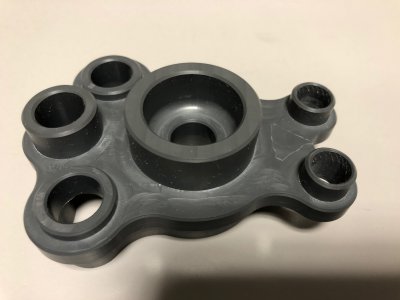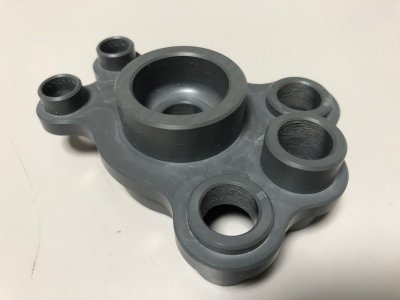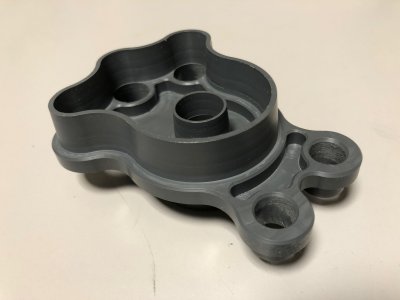- Joined
- Mar 26, 2018
- Messages
- 2,724
I have always had the climb-cut-on-X-chatter- while-roughing issue.
I'm not sure if I have noticed it before or if I always just thought it was a limitation of machine rigidity. I've never been thrilled about the ballnut mounts, so I may remake them and repack the X screw while I am at it like I did on the Z. Now that I have all this power on the axis motors, I don't mind the screws being pretty tight. I know this will exacerbate wear, but I just can't imagine I'm going to wear the screws out with the way I use them.
Not sure, but I plan to take it apart soon to diagnose.
Let me know what you find!
The part looks good! You can also play with the Horizontal Area toolpath for finishing floors. Many times you can select the entire solid and it will do what is possible with the selected tool, then maybe unselect the features you need more control over and address those in a different OP. I don't use it much, but it sure is handy sometimes.
OK I',m all ears for tips here. I normally do a dynamic roughing, dynamic rest machining, followed by a multipass contour to get the walls looking nice. Unfortunately I have yet to come up with a good way to finish the floor. I'll play around with that toolpath. I feel like I have "mastered" (as much as a hobbyist could I guess) only 3-4 toolpaths and the rest are just a mystery to me. I know what the rest are supposed to do, but I can never get them to look how I want.
Here is an old video. The chatter is heavier when moving in X+. It has always done this to some degree, but did progressively get worse.
Mine sounded very similar, although perhaps a little less bad, granted I was cutting plastic. IS there a downside to cutting conventional when CNC'ing, particularly the home hobbyist?
As you suspect, chatter is likely one of the following:
Ballscrew nut to saddle
Ballscrew housing bearing
Ballscrew bearing housing to table
Y-axis gib loose(ish). That's the easiest to check & fix.
Time to tear it down again! Maybe I'll make new ball nut mounts ahead of time so I can swap everything out at once.
In addition, you're using the TTS which likes to chatter with long gauge lengths. Crank down on the drawbar until your PDB just barely releases, stick that roughing end mill in a shortie setscrew holder instead of the collet and go to town.
Yeah, not ideal. I only have the ER20 chucks. The genuine Tormach ones used to be pretty cheap, but now I cry when I see the price. I paid $18 each for my chucks, including shipping. That being said, the Tekniks collets I've been buying are pricey and get me up to the original cost of the tormach stuff. Any tips on how to hold drills in something other than a collet chuck? The drill chucks are so long and chew up a lot of my Z travel.
Hog the plastic with a 1/2" corncob once you double-check your backlash suspects. With that spindle motor you should be making chunks.
It should, but I haven't yet gotten confident enough to really put it to work. I get in the mentality that slow and safe is good and then I never push the machine hard.
And 3 hours to program? That's fast for someone who doesn't do it for a living. Seriously.
Thanks. I pick up software pretty quickly, but I get stuck on the speeds and feeds. I know how to calculate them, but I don't always have a good feel for how hard to run the machine.
Nice job on the part. Learn from the 'oops' and have another go at it.
Will do! I have a pile of other edits which should just make everything run better.




